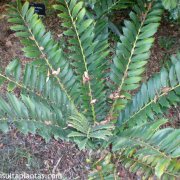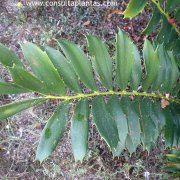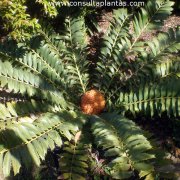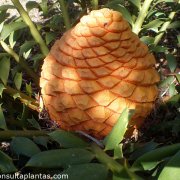Care of the cycad Encephalartos ferox or Zululand Cycad |
|
The genus Encephalartos, family Zamiaceae, comprises 60 species of cycads native to Africa. Some species are: Encephalartos ferox, Encephalartos altensteinii, Encephalartos senticosus, Encephalartos natalensis, Encephalartos horridus, Encephalartos villosus, Encephalartos lebomboensis, Encephalartos lehmannii, Encephalartos transvenosus, Encephalartos aemulans, Encephalartos paucidentatus. Common names: Zululand Cycad, Maputaland Cycad. This species is native to Mozambique. They are dioecious plants with an underground stem that reach 1 meter (3.28 feet) in height. The leaves are 2 meters (6.56 feet) long and are formed by spiny leaflets that resemble the leaves of the Ilex aquifolium. They produce showy orange or red egg-shaped female cones; male cones are cylindrical and can measure 50 cm (1.64 feet) in length. Zululand Cycad is used in gardens as isolated specimens under trees or shrubs in cool areas of the garden. It's ideal for Mediterranean coastal gardens. Encephalartos ferox prefers semi-shade exposure and warm temperatures. It resists light and occasional frosts. The soil must be very well drained and contain leaf mulch to be fertile. Maputaland Cycad needs more water than other species; water regularly (never overwater) waiting until the substrate is almost dry. Fertilize with compost in early spring and with a slow-release mineral fertilizer in early summer. Zululand Cycad does not need pruning. Encephalartos ferox is a resistant plant to the usual pests and diseases. Maputaland Cycad propagates by seeds sown in spring but it is a slow process (up to 7 months to germinate); it's easier to propagate it from the suckers that the plant sometimes produces at the base. |
Images of the cycad Encephalartos ferox or Zululand Cycad |
Find plants
Encephalartos ferox or Zululand Cycad | Care and Growing
© 2026 FavThemes





